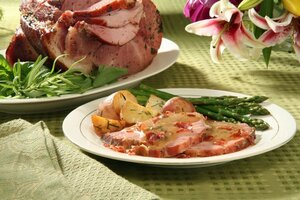Two recipes for Easter ham
Whether you are preparing a feast for a crowd or a meal for two, ham is an Easter tradition.

Ham can be roasted, broiled, pan-broiled, or cooked in a variety of sauces.
PR NEWSWIRE/Newscom
This article first appeared in The Christian Science Monitor on April 18, 1984, titled "Ham – an Eastertime tradition"
Ham has been traditional Easter fare throughout the centuries. But why specifically ham rather than pork in general? Barbara Ketcham Wheaton, a food historian and author, suggests it may be because ''meat was not eaten during the Lenten season and so was scarce in early spring.
''But,'' she adds, ''farmers and peasants, having fattened their pigs on the last of the harvested corn before slaughtering them, usually had a cured ham available, hanging in the barn from the past winter.
''Lamb was available to some extent, but because ham couldn't be eaten by Muslims or Jews it took on a peculiarly Christian significance.''
Because of the varieties of smoking and curing processes used to preserve ham, the preparation of it has evolved over the centuries.
Hams are now available fresh, honey-glazed, salt-cured, smoked, bone-in, semi-boned, or boneless. It is also available canned, in sizes ranging from 1-1/ 2 to 13 lbs.. Several countries – Poland, Denmark, and the United States, to name but a few – export ham.
Prices vary according to size, amount of bone, and curing processes.
Ham can be roasted, broiled, pan-broiled, or cooked in a variety of liquids.
''Water added'' on the label refers to hams to which a solution of salt, sugar, and nitrites has been added as part of the curing process.
Most hams are fully cooked during processing and can be served cold or heated in a 325-degree F. oven to an internal temperature of 130 degrees F.
Cook-before-eating hams are usually labeled as such and should be roasted on a rack in a 325-degree F. oven until the internal temperature reaches 160 to 170 degrees F. A meat thermometer is the best guide to accuracy in cooking any meat.
According to the National Live Stock and Meat Board, if there is no label, you should assume that the ham should be cooked before eating.
Leftover ham may be chopped and added to soups, salads, and casseroles or ground and used as sandwich spreads.
Here are some general rules regarding storage:
- Never wrap ham in aluminum foil, as the salt used in curing may cause corrosion.
- Canned ham may be refrigerated opened 1 week. Leftovers may be refrigerated in plastic wrap or bags.
- Cured and smoked ham may be refrigerated in original packing for 1 week.
- Ham should not be frozen, as freezing causes changes to both flavor and texture.
Ham with pineapple rings has become such a cliche that it's worth avoiding. Instead, consider a non-edible garnish of fresh spring flowers.
The following two recipes are from James Beard's ''American Cookery."
Ham Baked in Cider
1 10-lb. ham (not aged)
Cider, enough to cover ham
1 cup brown sugar
2 teaspoons mustard
Cloves
2 cups bread crumbs
For the cider sauce:
2 cups cider used to soak ham
1/2 cup seedless raisins
1/4 teaspoon nutmeg
1/4 teaspoon ground cloves
2 teaspoons cornstarch
1 tablespoon cider
Soak ham overnight or longer, skin side down, in enough cider to cover.
Preheat oven to 320 degrees F.
Remove ham from cider and place on rack in a roasting pan. Bake, allowing 20 minutes per pound. Baste from time to time with the cider.
Remove from oven, and strip off skin. Mix together sugar, mustard, and bread crumbs. Spread over ham and dot with cloves. Return to oven and bake an additional 1/2 hour, basting occasionally with cider.
When ham is done, prepare sauce. Combine cider and raisins in a saucepan. Cook over low heat for about 5 minutes. Stir in spices. Combine cornstarch with 1 tablespoon cider, add to sauce pan, and continue stirring until sauce thickens slightly.
Serve sauce over ham.
Baked Ham Slice
Serves 2 or 3
2-inch thick slice of ham
1/4 teaspoon nutmeg
Pinch of ground clove
1 teaspoon mustard
1/2 cup cider
1/4 cup maple syrup
Preheat oven to 350 degrees F.
Combine spices with mustard and rub into both sides of ham slice. Place in baking dish. Mix together cider and syrup and pour over ham.
Bake for 1-1/4 hours, basting occasionally.
